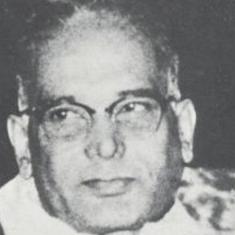Consumer goods companies in the West had occasionally used sachets to entice consumers to try new shampoos and laundry detergents. But it was in emerging markets like India that companies realised the full potential of the plastic sachet.
As a mainstream, everyday package, the sachet unlocked enormous multi-billion-dollar markets that had long been out of reach, promising a rush of new growth, courtesy of some of the world’s poorest people, just as sales in developed markets started to slow.
Indian shopkeepers had long found their own ways to make products like soap and laundry detergent affordable for the hundreds of millions of Indians – particularly in the country’s villages – who couldn’t afford a full bar or bag. They opened up 1kg bags of washing detergent powder and sold 100 grams at a time for 1 rupee, dispensed into people’s own containers. They cut bars of soap into smaller pieces, selling these individually.
By the late 1980s, Unilever’s India subsidiary – Hindustan Lever – had begun packaging its shampoo brands Sunsilk and Clinic in sachets that held just enough for a single wash. “There was a realisation in Unilever decades ago that people on daily wages also have the same aspiration as people on monthly wages,” says Vindi Banga, former chairman of Hindustan Lever. “That is the genesis of the single-use pack.”
Unilever had been selling its products in India since 1888, when crates prominently printed with the words “Made in England” landed at Calcutta’s harbour. The crates carried Sunlight soap. More products followed and, by 1931, Unilever had set up its first Indian subsidiary, making vanaspati, a low-cost substitute for ghee.
Over the years, Hindustan Lever’s in-house army of psychologists and market researchers had worked to more fully understand the motivations fuelling the Indian housewives who were its main customers. They visited the women’s homes and brought groups of them together for tea, spending a long time getting them to relax so they’d talk freely. Among the valuable insights this time-consuming method of market research yielded was that the company’s relatively pricey soaps were often bought by poor women.
“It is not necessarily the rich woman who buys Sunlight,” explained Hindustan Lever’s chairman SH Turner at the company’s annual shareholder meeting in 1958. “It may be the poor woman who values its lather and the ease with which she can do her washing with it; the rich woman whose washing is done for her by servants often feels that they are so wasteful to [sic] soap anyway that it is best to buy for them the cheapest brand on the market.”
Hindustan Lever’s researchers also found that there was little knowledge of the company’s brands, particularly in rural India. Farmers spent the most on food, tube wells, fertilisers, seeds and farming equipment. Weddings were a high priority too – these needed to be opulent in order to raise the family’s standing. Next came consumer durables like bicycles, sewing machines and radios. At the very bottom were the kind of packaged goods Hindustan Lever sold, like soap and vanaspati.
To convince Indians they needed products they had long done without – like liquid shampoo and powdered laundry detergent – Hindustan Lever deployed its multi-million-dollar marketing machine. “All consumer goods manufacturers must spend a lot of money on advertising – particularly in India,” said Turner in his 1958 speech. Advertising, he explained, “may often be required to introduce the product as one which is a necessary part of a higher standard of living”.
Decades later, in 2014, Unilever’s Southeast Asia head would once again describe the industry’s approach to demand creation, outlining for investors how Unilever was creating a market for dishwashing soap. “You can actually clean dishes with ash and salt. It works,” he said. “But my task is to convince consumers that there is a better, more hygienic, faster, less residual solution. You need to convince consumers that their proxy is not good enough anymore.”
To create new markets in rural India, Unilever employed a totally different model to the one it relied on in the West. Back in the 1960s, most Indian villages were “media dark”. Hardly anyone had a TV and most people were illiterate. Hindustan Lever found ways to advertise to them anyway. It had a fleet of 12 vans that drove around villages showing Bollywood and local language films, either on TVs played from the backs of the vans or on roll-down screens. People happily sat through dozens of Hindustan Lever advertisements in exchange for the entertainment.
Another seven vans drove around doing demonstrations: Hindustan Lever’s marketers showed people how to use its soaps and detergents by physically washing clothes and half-clothed bodies in public. They performed skits and puppet shows. They travelled around the country painting advertisements for Unilever’s brands on the walls of village compounds.
Operating and maintaining the vans across enormous distances on bumpy rural roads was expensive. The cost of marketing to each viewer of Unilever’s rural cinemas was 25 paise, a whopping 125 times higher than the 0.2 paise it cost to similarly reach an urban consumer.
The efforts didn’t justify the paltry sales of low-cost soaps and cooking oil they drummed up. But Unilever stayed the course. Its polling showed that once workers received regular pay, their interest in buying packaged food and soap rose. Unilever’s executives saw the potential to turn millions of Indians into consumers by stirring what the company claimed were their nascent desires.
The key to making money from low-priced (and hence inevitably low-margin) products was driving enormous sales volumes – selling billions upon billions of products. “Economies come largely from mass production and mass selling of standardised lines,” Turner told Hindustan Lever’s shareholders in his 1958 speech. “We must have products which are acceptable alike to the rich and the poor.”
The single-use multilayer plastic sachet, which Unilever would only successfully roll out some three decades later, enabled the kind of mass selling that Turner knew was needed to turn a fat profit in a poor country. Sachets would become Unilever’s primary way to level the playing field in India, offering the same products to rich and poor. In time, they’d catch on widely, with thousands of different consumer goods brands opting to use the tiny plastic packs.
“In India, everything is sold single. You can buy one banana, one cigarette, one egg and – whether it’s pickle, hair oil or salt – you can buy it in a sachet form,” says Anand Kripalu, who worked at Unilever for more than two decades before leaving in 2005 to become Cadbury’s south Asia head. “The best example of how sachets exploded a category is shampoo,” he adds. “They put shampoo within reach of hundreds of millions of people overnight.”

Excerpted with permission from Consumed: How Big Brands Got Us Hooked on Plastic, Saabira Chaudhuri, Blink Publishing.










